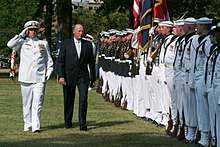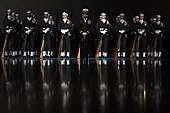United States Navy Ceremonial Guard
The United States Navy Ceremonial Guard is the official ceremonial unit of the United States Navy. It is responsible for the performance of public duties in the U.S. Navy. The guard is composed of 200 enlisted navy personnel. It is based at Naval District Washington, Washington Navy Yard, Washington D.C. It is currently led by Commander Dave Tickle.[1]

Overview
_Fife_and_Drum_Corps_lead_the_inaugural_parade_as_part_of_the_president's_escort_on_Pennsylvania_130121-D-DB155-005.jpg)
Established in 1931, the United States Navy Ceremonial Guard represents the Navy in the Presidential, Joint Armed Services, Navy and public ceremonies in the nation’s capital and around the world. Each member is trained to be motionless for extended periods of time so that they will be prepared to hold their bearing through the entirety of the longest of military ceremonies. They are trained in the areas of rifle drill manual and marching as well as the daily labor of maintaining the rigorous physical and uniform standards demanded of Ceremonial Guardsmen.
List of specialized platoons
- Ceremonial Drill Team
- Color Guard
- Firing Party
- Casket Bearer
Requirements
- Recruits must undergo an intensive 10-week training program before they are considered a guardsman.[2]
- It is a requirement for a sailors in the ceremonial guard to have a minimum height of 183 centimeters (6 ft 0 in). Officers are required to have a minimum height of 178 centimeters (5 ft 10 in).
- Ceremonial Guardsman are required to remain sober while on duty.
Mission

The United States Navy Ceremonial Guard provides along with ceremonial honour guards from the U.S. Army, U.S. Navy, U.S. Coast Guard and the U.S. Air Force during State visits to the United States at the White House and the Pentagon, as well as the inaugural parade every four years, and Independence Day observances in Washington, D.C.. Its personnel serve as Casket bearers, Color guards, and Firing parties at the funerals of Naval Servicemen at Arlington National Cemetery. They also have the Navy ceremonial Guard Drill team that performs all over and outside the U.S.[3][4]
Navy Ceremonial Duty Ribbon

The Navy Ceremonial Duty Ribbon is presented to members of the ceremonial guard who, receives their full honors qualification, and completes a standard tour of duty (2 years) with the United States Navy Ceremonial Guard.[5] It was established on 12 December 2003 by order of Secretary of the Navy Gordon R. England. On 17 January 2012, the name of the Navy Ceremonial Duty Ribbon was changed[6] from the U.S. Navy Ceremonial Guard Ribbon in order to encompass those personnel who have successfully completed a standard tour of duty on board USS Constitution. Multiple awards of the Navy Ceremonial Duty Ribbon are denoted by bronze service stars, while only one award of the ribbon is authorized for each tour of duty.
Uniform
For the Ceremonial Guard, the enlisted Full Dress uniforms are more elaborate with the wearing of a white pistol belt, ascot, and dress aiguilette (the latter two are white for winter and navy blue for summer), and white canvas leggings. This uniform is due to be replaced in 2021.[7]
Gallery
 Enlisted Full Dress Whites worn at a Change of Command Ceremony in 2009.
Enlisted Full Dress Whites worn at a Change of Command Ceremony in 2009. The Kevin M. Kimsey plaque.
The Kevin M. Kimsey plaque. Sailors assigned to the Ceremonial Guard color guard.
Sailors assigned to the Ceremonial Guard color guard. Members of the Navy Ceremonial Guard parade the fifty state flags before a wreath-laying ceremony at the Navy Memorial in Washington D.C.
Members of the Navy Ceremonial Guard parade the fifty state flags before a wreath-laying ceremony at the Navy Memorial in Washington D.C..jpg) The Navy Ceremonial Guard Drill Team perform during Navy Week in Montana.
The Navy Ceremonial Guard Drill Team perform during Navy Week in Montana.
Notable Members
See also
External links
| Wikimedia Commons has media related to United States Navy Ceremonial Guard. |
References
- https://www.cnic.navy.mil/regions/ndw/about/ceremonial_guard/biographies/John_Giuseppe.html
- https://www.military.com/military-report/9-selected-for-navys-ceremonial-guard.html
- "The ceremony began with colors presented by the United States Navy Ceremonial Guard while the national anthem was sung by a member of the U.S. Navy Band". Okinawa Stripes. Retrieved 2018-03-30.
- http://www.dcmilitary.com/base_guides/joint_base_anacostia-bolling/mission_tenants/u-s-navy-ceremonial-guard/article_c6bca3db-6d12-562c-9271-8100d9b1527d.html
- https://awards.navy.mil/awards/webapp01.nsf/(vwAwardsDisp)/AW-10052085N4XK?OpenDocument
- Bird, J.M. (August 2019). "SECNAV M-1650.1" (PDF). Washington, D.C.: United States Department of the Navy. Retrieved October 30, 2019.
- http://www.public.navy.mil/bupers-npc/support/uniforms/uniformregulations/chapter6/Pages/6201.aspx
- http://www.arlingtoncemetery.net/kmkimsey.htm
- https://www.findagrave.com/memorial/72316874/robert-conway-martin
- https://www.findagrave.com/memorial/16141477/brian-anthony-moss
